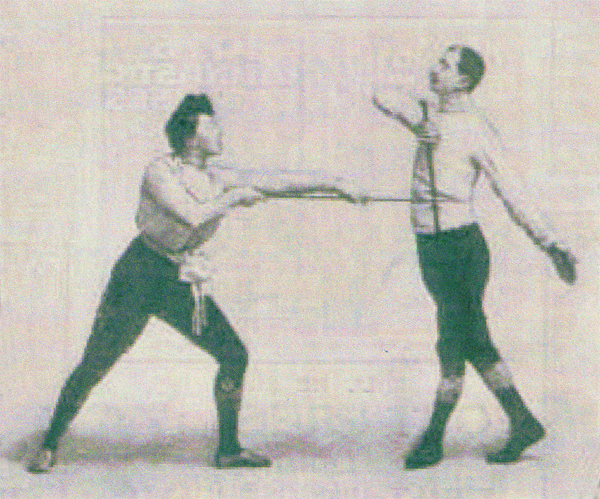- Originally published on the Bartitsu.org site on Thursday, 30th August 2018

Hailing from the Alpine village of St. Crois, wrestler Armand Cherpillod was the last full-time instructor to join the staff of the London Bartitsu Club. According to Cherpillod’s memoirs, E.W. Barton-Wright sent Pierre Vigny to Switzerland with the express intention of bringing a wrestling champion back to London.
It’s likely that Cherpillod was approached because the then-current war of words between Bartitsu founder Edward Barton-Wright and the English wrestling establishment had reached a stalemate. The wrestlers refused to accept Barton-Wright’s challenge for them to compete with his club’s champions under jiujitsu rules, and Barton-Wright refused to allow Yukio Tani and Sadakazu Uyenishi to compete under other rules.
Bringing Cherpillod in as a “ringer”, having him train with Tani and Uyenishi and then fight under catch-as-catch-can rules was a clever tactic on behalf of Barton-Wright. Representing the Bartitsu Club, Cherpillod won his match against the famous wrestler Joe Carroll during a highly-publicised Bartitsu tournament, and then continued into a successful career as a challenge wrestler both in England and on the European Continent.
The following article, translated from the Revue Olympique of January, 1905, highlights Cherpillod’s take on jiujitsu atemi-waza (striking and nerve pressure techniques). It’s both interesting and unusual in that, although Barton-Wright’s own original articles for Pearson’s Magazine had included a variety of atemi-waza, that class of techniques was not emphasised in the books later produced by Tani and Uyenishi.
Atemi methods were, however, also detailed in some of the books written by second-generation instructors, such as W. Bruce Sutherland. The British Jujitsu Society – which largely consisted of instructors who had been trained by Tani and Uynenishi – later produced a pamphlet detailing the same branch of skill, titled “The Art of Ju-Jitsu: Nerve Pinches and Fatal Blows”, which is reproduced in The Bartitsu Compendium.
The translated Revue Olympique article follows:
Among the first European followers of jiu-jitsu is the world champion of freestyle wrestling, A. Cherpillod, who arrived in London during the year 1901 as a teacher at the Bartitsu Club, where he met with the Japanese masters Uyenishi and Tani. An exchange of teaching took place between these athletes, as they began to introduce each other to the beauties of their arts.
Returning to Switzerland, Cherpillod taught some colleagues about the principles of jiu-jitsu and, when in charge of a wrestling course at the Royal Naval Officers at Portsmouth, he joined them in performing demonstrations of the Japanese method. He perfected his own skill and acquired some good pupils. Finally last year, Cherpillod, assisted by his friend, the distinguished Professor E. Richème, of Neuchatel, prepared his little practical manual of jiu-jitsu, which enjoyed considerable success.
Mr. Cherpillod considers that jiu-jitsu and European freestyle wrestling have a common origin and that the former is only a particular style of freestyle wrestling, starting from the initial common principle of seeking defeat of the adversary without any regard for convention, every technique being good provided it tends to the desired result. In ancient Greece, writes the author, “freestyle wrestling became the object of public competitions. The progress of civilisation and certain sporting considerations gradually softened the brutality of these matches. Thus, over the course of centuries, conventions emerged, mainly leading to the recognition of the touch of the shoulders to the ground, or a similar position, as the end of the fight.
It follows from this that freestyle European wrestling would have lost, by becoming civilized or sporting, all that the Japanese style has gained in science and in virtuosity by its independence and freedom. It is this virtuosity which gives jiu-jitsu the appearance of a mysterious art, thanks to the success that those who practice it invariably win over all the athletes constrained by modern (i.e. Western) conventions and incapable of realizing the scope of an art which systematically ignores the outdated rules of which they are imbued.
This judgement is interesting; it seems a little sketchy, perhaps, in disregarding some of the fundamental originality of the Japanese method. The latter recommends itself in two points which do not appear to him to be common with any other kind of free wrestling; the role played by the fingers and the whole hand – and also through the intervention of scientific anatomy.
But, of course, Mr. Cherpillod did not fail to appreciate the importance of these two points when he himself became a jiu-jitsu expert and that is why it is astonishing that he has not emphasized them by giving in his textbook a general overview of the Japanese style; on the other hand, when it comes to what might be called the preliminary preparation in jiu-jitsu, the famous Swiss athlete ascribed to the first rank the exercises of the hand and anatomical study.
The general gymnastic method he indicates does not call for any comment. Certain movements are hardly different from those which are customarily taught to obtain relaxation of the whole body. The author has no preference; he says so overtly. We even take note of this clear theory, so contrary to the excitement of the day, and for which we express our warm sympathy; “All systems are good, provided they are applied consistently.” There is no master of gymnastics who can not apply a rational training program capable of developing the strength of the limbs, the flexibility and resistance of each part of the body. To arrive at a determined result, it is enough to create a system and to practice it every day with perseverance.
That being said, Mr. Cherpillod comes to the preparation of the hands and the indication of the vulnerable points of the human body; these are essential elements of jiu-jitsu. A trained Japanese fighter can, with a single stroke of the edge of the hand against the neck, dislocate cervical vertebrae and bring death. There are not many ways to train in this regard. It is necessary, with the hand well open, the fingers held tightly, to strike or slice at a very hard object as violently as possible, with a percussive blow; you must not only repeat this exercise a very large number of times, but vary it by striking from top to bottom, from bottom to top, from right to left and from left to right.
Vulnerable points in the human body are not all affected by the same techniques, nor in the same way. Some are sensitive to torsion, others to pressure; others again must be assailed by a sharp blow of the hand. Here is the enumeration furnished by M. Cherpillod:
1. Points sensitive to torsion or reversal ending at the same time by the disarticulation of the grasped member:
- the fingers – the wrist – the arm at the elbow – the junction between the arm and the shoulder. The foot and knee could still be mentioned, although the blows there are both less effective and more difficult to perform.
2 – Sensitive pressure points:
- the eyes – the depression of the nose at the base of the forehead – the nose (pushed upwards or the nostrils inside) – the hollow below the ears – the carotid – the inner muscle of the arm immediately above the elbow or pinched ten or fifteen centimeters from the armpit – the wrist at the pulse point – the back of the hand in the interval between the three middle fingers – the first joint of the little finger – the skin of the belly directly below the hollow of the stomach – the ankle.
3 – Points sensitive to strikes with the hand:
- the temple – the nose from bottom to top – the Adam’s apple – the side of the neck under the jawbone and above the clavicle – the nape of the neck – the clavicle – the back above the shoulder blades – the bottom of the vertebral column at the hollow lumbar – the hollow of the stomach – the flank below the false ribs – the groin – the point between the biceps and triceps muscles as well as the middle of the forearm and the wrist joint – the middle of both sides or the femur – the middle of the front of the tibia in front – the toes.
It will be noticed that, practically, there is a ranking to operate between all these points; many of them, while they might be excellent attack points upon the naked body, are usually protected by clothing.
It will also be noted that they are not all easy to determine, other than in theory. First, there are the individual physiques to be taken into account, the real anatomy of men differing considerably from one to the other; but, even on a normal man, a strike may not invariably land upon its target, especially if it is a quick and sudden movement.
Now, in Jiu-Jitsu, as in every other form of fighting, accuracy in partnership with speed leads most surely to success. Hence the precision exercises to which the Japanese attribute real importance, but which the Swiss champion seems to leave a little aside. It is said that, in Japan, one sometimes uses the following process: a man draws upon a table a series of small circles in pencil, then he steps away from the table first one pace, then two, then three, and he suddenly lunges and places his finger in one of the circles. We can do the same thing with a piano keyboard, aiming to depress this or that key.
There is, of course, no equivalent exercise that can be performed upon the body of an adversary, and, to tell the truth, we do not believe that, without an adversary, one can acquire even a summary knowledge of jiu-jitsu.
On the other hand, it is always good to study etudes (formal exercises) and any work in physical culture should more or less start with those. The jiu-jitsu etudes are exercises aimed at hardening the slice of the hand, the strength and agility of the fingers, as well as the knowledge of the points of attack and in the way to use this knowledge both quickly and precisely.































